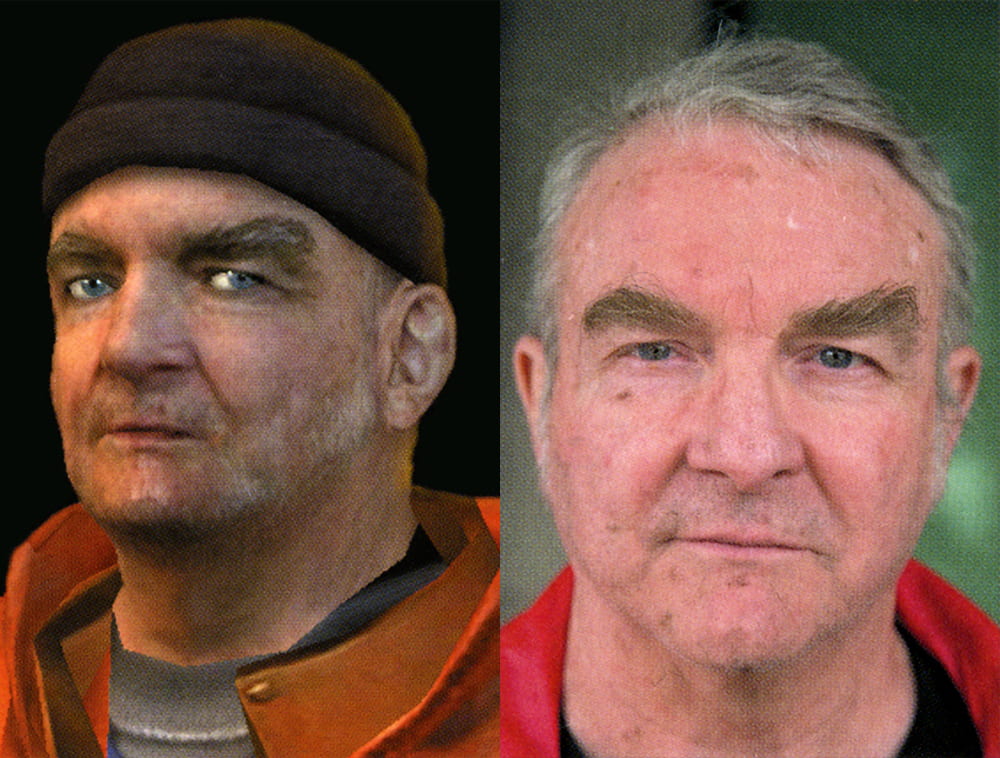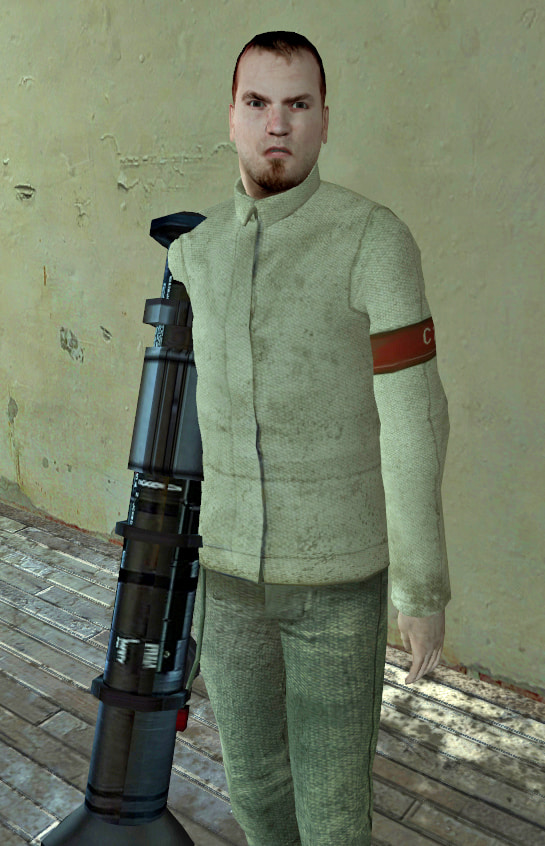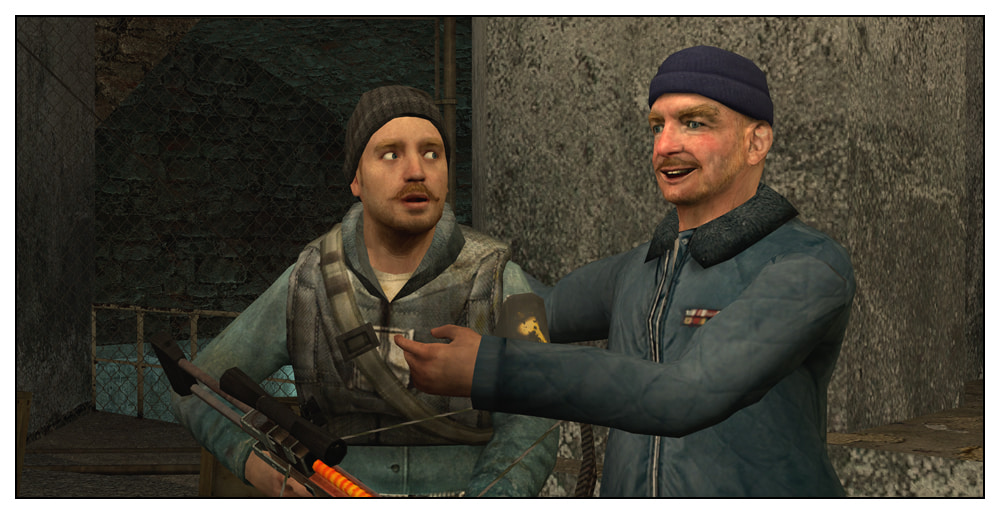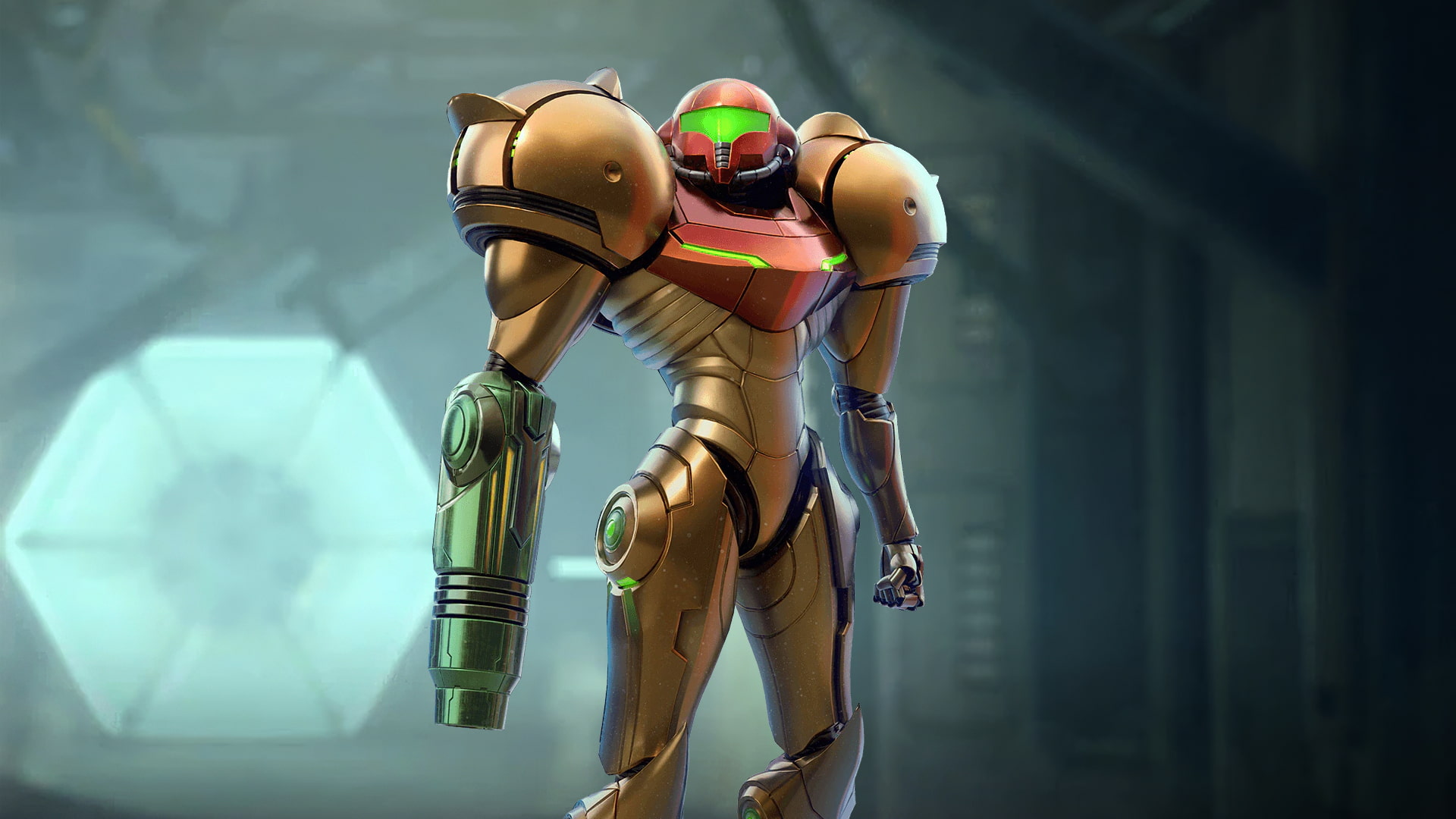About halfway through Half-Life 2, you reach a small coastal settlement just off Highway 17. Unable to get past a locked gate, you’re quickly pushed into a nearby basement, where a man with a dubious accent is giving a lecture on rocket launchers. The man hands you a rocket launcher of your own and you soon find yourself fending off against a Combine gunship. After the fight, the same character gives you some quick pointers and you’re back on the road, never to see him again in the entire Half-Life series.
Despite this briefest of appearances, Colonel Odessa Cubbage is a surprisingly memorable minor character in Half-Life 2, one who, regardless of having only 19 lines in the entire game, somehow earned his own Wikipedia page at one point and warranted a few rare mentions in the subsequent Episodes.
In this article, let’s dive into what makes the good Colonel so beloved by the fan community, how his origins are tied to, of all things, the Legend of Zelda series, and why he represents a stepping stone from classic first-person shooters to their modern, story-driven counterparts.
Who is Odessa Cubbage?

Appearing in the Half-Life 2 chapter Highway 17, Colonel Odessa Cubbage is the commander of New Little Odessa, a small settlement in the Coast — presumably named after himself — that Gordon Freeman reaches on his way to rescue Doctor Eli Vance from Nova Prospekt. Odessa is the one who grants Gordon his rocket launcher in Half-Life 2, which is used immediately after in the very first fight against a Combine gunship. Notably, he’s also one of the few characters in the series seen interacting with the mysterious G-Man, in a blink-and-you’ll-miss it moment prior to arriving at NLO.
Unlike most minor characters in Half-Life 2, who recycle the citizen models, Colonel Cubbage has his own unique model. His appearance is that of a middle-aged man with an extravagant moustache, blue eyes and blond (apparently dyed) hair, wearing a University of Rochester Security Services coat and a blue knit cap. He is voiced by John Patrick Lowrie, who also voiced the citizens and most other one-off characters, with a boisterous and somewhat forced British accent.
Besides his one appearance in Half-Life 2, Odessa Cubbage is only referred to again in Half-Life 2: Episode One, once by Alyx Vance — who jokingly calls him her father when someone mistakes her for Kleiner’s daughter — and otherwise by random citizens, a few who claim to have met Odessa and think of him as an idiot or blame him for everything, and at least one who believes Odessa Cubbage killed the first gunship, rather than Gordon Freeman.
Not much is known about Colonel Cubbage outside of his brief appearance. In-game, he is portrayed as a sycophant towards Doctor Freeman and a bit of a coward, staying in the basement to use the radio during the fight despite claiming he’ll lend Freeman a hand. The rebels of his outpost, New Little Odessa, seem to respect him, referring to him with reverence as “the Colonel”, although future mentions by other rebels are not as kind. He also obviously has at least theoretical knowledge on the rocket-propelled grenade launcher, seeing as he is met while giving a lecture to his troops (and, indirectly, the player) on how to use it against a gunship.
As aforementioned, Odessa Cubbage is also part of the select group of characters with first-hand knowledge of the G-Man, as he can be spotted through Combine binoculars talking to the enigmatic figure before Gordon arrives at New Little Odessa, although the contents of the discussion can only be guessed.

The only official description of Odessa Cubbage comes from the Half-Life 2 Official Prima Guide, which gives a bit more detail about the character (also the only notable minor character to get his own section):
Odessa Cubbage, a.k.a. The Colonel, is the feisty leader of a small band of rebels located in New Little Odessa. Whether the town was named after him or whether he took the name from the village is uncertain. In fact, much about the Colonel is open to question: from his slightly askew mustache, to his supposedly British accent, which many suspect is as false as the military exploits with which he regales his followers. He seems far too young to have been a Bengal Lancer, or to have served with Rudyard Kipling. There is only one certainty when it comes to Colonel Odessa Cubbage: In times of peril, you will always find him in the basement Headquarters, dispatching firm orders and bravely sending warnings to neighboring outposts, while never exposing himself to the slightest personal harm.
How much of this description can be considered valid (or “canon”, although Half-Life plays very loosely with the term) is up for debate. While nothing directly contradicts what we know from the games, there is also no evidence on who actually authored this bio — meaning, it could very well be an embellishment written by the Prima Guide’s author, rather than originating from Valve’s own staff. Either way, it serves as a foundation for much of the Colonel’s characterization among fans: that of a questionable character with an affected accent whose reputation varies from idolization among his own crew and spite among everyone else, Alyx “My father is Odessa Cubbage” Vance included.
The unlikely origins of Colonel Cubbage
To tell the origin of Odessa Cubbage, one must first talk of two separate stories: that of Odell, a character from the infamous Half-Life 2 beta, and that of the “rocketman”, from a bit later in development.
Odell, the engineer
It’s perhaps no news that the development of Half-Life 2 was, to put it nicely, turbulent. That’s what happens when you try to follow up on one of the greatest and most revolutionary games of all time. Combined with the relatively open ending of the first game and a desire to do something different, that meant that the story of Half-Life 2 took many twists and turns before what we would eventually get.

At first, Half-Life 2 was meant to open on an icebreaker that had a name which would grow very familiar to fans — the Borealis. Gordon Freeman would somehow get on the boat, initially meant to be a Resistance vessel, and meet the sole surviving crew member of the Borealis, an engineer named Odell, who would help Gordon navigate the ship and eventually escape by submarine to another cut Resistance base. Odell had his own unique model, wearing an orange survival suit and a dark beanie and having a face modelled after the martial arts teacher of one of the team members. A face that will probably look eerily familiar if you’ve made it this far, but we’ll get to that.
The chapters of the Borealis would be shuffled around during development, at one point being set after Gordon raided a Combine facility known as the Air Exchange, before eventually being cut altogether from the game, with the Borealis being repurposed much later to set up Half-Life 2: Episode Three. That means that, among many other things, the model for the character of Odell was removed from the game, leaving a fully developed face model on the cutting room floor.
(As a quick aside, there’s good evidence to suggest that Odell would later inspire another character in the Half-Life series. In the latest installment, in fact — namely, Half-Life: Alyx’s Russell. As you’ll probably realize reading this article, Valve has a smart tendency to reuse the good concepts they leave behind.)
The “rocketman” (no, not Elton John), a.k.a. “RPGGuy”
At another point during development, the gameplay led to an area early on during the coast section where the player would get the rocket-propelled grenade launcher, or RPG for short, and have their first boss encounter with a Combine gunship. This setpiece eventually grew to become a small settlement the player would make their way towards and fight the gunship in.
In most games up until this point — including the first Half-Life, in fact —, such a gameplay situation would usually involve the player picking up their shiny new gun from the floor and immediately using it against their big bad enemy. Half-Life 2, however, was different; not only did the developers want to teach the player how to use their newfound weapon, but they were also aiming for loftier goals in regards to storytelling.
In particular, Marc Laidlaw, writer of the Half-Life series up to that point, was particularly inspired by the Legend of Zelda series, which by then had a habit of filling up the world with very memorable but otherwise inconsequential characters, culminating in a game that was driven by nothing but memorable characters and their related side-quests, Majora’s Mask.

As such, there was a desire in the Half-Life 2 team to not just perfect their gameplay, but also flesh out their world in a similar fashion, which led to the creation of minor characters such as the Consoling Couple — directly inspired by (and, arguably, a homage to) the Dancing Couple, a.k.a. Honey and Darling, from Ocarina of Time and Majora’s Mask — and Sandy and Laszlo (“the finest mind of his generation”).
Likewise, when the time came to introduce the player to the RPG, the team thought bigger. Marc Laidlaw himself explained it best in his his presentation at the Game Writers Conference of 2005, which he shared as the article “The Hypermodern Muse” in his blog (well worth a read, by the way):
Well, okay. In the old days, you would just put that rocket launcher in the middle of a room, maybe give it a spin, and expect the player to run over it and pick it up automatically. The underlying goal has not changed at all. We’re about to bring out a big monster. It’s time to give the player a weapon that can handle it. But once you’ve made the decision not to simply leave the rocket launcher in the middle of the floor, well, the sky’s the limit. In this case, we found ourselves with an opportunity to create a character, and a scene.

This proto-Odessa Cubbage, or “rocketman” (named in the leaked game files as “RPGGuy”), was initially just a random citizen model who talked big and ran outside to fight the gunship, only to unceremoniously die and leave the task up to the player. Complications with the player getting the RPG outside under gunship fire eventually led to a change in scenario, originally with the gunship using its belly cannon, cut from the final game, to obliterate the shack the RPGGuy was holed up in. That itself would change, as Marc paraphrases:
From that point, it was a fairly small step to decide that Odessa Cubbage was actually a royal coward. He ordered his starry-eyed contingent about but never exposed himself to any actual danger. We gave him a fake English accent to make the player suspicious, and in the final detail work, we put a little dye in his hair. Everything about him reeks of the dubious. In some ways, the legend of Odessa Cubbage is as much fun to create as the legend of Gordon Freeman. And yet essentially he is one step up from taking that rocket launcher and sticking it in the middle of the floor just as a gunship shows up.
As Odessa Cubbage evolved from random nameless NPC into a character — and got a name from a spam e-mail, of all places —, the developers presumably realized they had a perfectly fitting model lying about: that of Odell, the cut character, who seemingly looked dubious enough to pass off as this new Cubbage persona, at least after a moustache was pasted on his face. From there, the location of the fight became New Little Odessa and the whole setpiece a brief and somewhat bizarre trip into what may best be described as a “cult of Cubbage”.
Whatever the case, it’s clear that the developers enjoyed the character quite a bit. Evidence shows that Odessa Cubbage was worked on until very close to release; the preview image for the Half-Life 2 model viewer has him garbed in a standard refugee outfit, which can also be seen in the Half-Life 2 Prima Guide, meaning that Odessa’s final model was presumably added very late in development.

In a way, Odessa Cubbage epitomizes both the hardships of developing Half-Life 2 and the exact reason why the game was so ground-breaking and is still so beloved by the community. The good Colonel is the result of not only the ever-changing status of the game during its five years in development and the scraps of cut content, but also of the developers’ intent to build a world more than just a game. There was no need for an Odessa Cubbage; a rocket launcher on the ground would have been enough. Instead, we got a minor character with more thought and personality than most entire casts of first-person shooters up until that point.
Odessa Cubbage and the fan community
As aforementioned, Cubbage has a very small role in the Half-Life saga as a whole: a few minutes of screen time in Half-Life 2 and a running joke in Episode One. He would live on, however, thanks to the fan community, particularly the Garry’s Mod comics crowd, which would reuse him endlessly in various ways.
The reasons as to why Odessa Cubbage became so popular with creators are not hard to figure out:
- For one thing, Odessa’s very minor speaking role means that not only is it very easy to both expand the character’s story and personality, but also, unlike main characters such as Alyx Vance or Barney Calhoun, there’s very little risk of contradicting previously established plot points;
- Those attributes could certainly also apply to most other minor characters in Half-Life 2, such as Leon, the leader of Shorepoint Base, but Odessa has the added attribute of having his own character model, making him instantly recognizable, whereas most minor characters use the default citizen models;
- That character model itself is hilariously quirky and playful, making him all the more appealing for creators to mess around with;
- Thanks to the combination of a boisterous military title and vague importance for the Resistance’s actual hierarchy, Cubbage has a flexibility in the roles a creator can give to him, from over-inflated buffoon in a more light-hearted series to an actually important, oftentimes despicable, presence in the rebel totem pole;
- Last but not least, there’s an air of mystery to Odessa Cubbage, aided by the fact that, as mentioned, he is one of the rare characters seen interacting with the G-Man, a moment that is never picked up again in the entire series.
Among the works you’ll find Odessa Cubbage in are: the seminal Garry’s Mod comic series Apostasy, where Odessa is portrayed as a serious figure in the Resistance; Subject 23, a three-part comic miniseries set almost entirely in New Little Odessa; the more modern cinematic comic epic Kaden, where Odessa is an unseen but important presence to the plot; and, of course, The Adventures of Hercule Cubbage, which has as its protagonist a fan-created son of the Colonel himself.

Outside of the realm of Half-Life 2 comics, you’ll also find Odessa in a starring role in the mod Avenue Odessa by Jason Gimba, an expanded version of a map created for the RunThinkShootLive CityStreetsVille mapping challenge, featuring a fully-voiced and perfectly characterized Odessa as a companion character.
It’s also worth noting that Odessa Cubbage had his own Wikipedia article for a surprisingly large amount of time, being first mentioned by Marc Laidlaw in his 2005 talk and lasting in one form or another until at least 2009, when his entry was merged into a generic “Characters of Half-Life” list, where he still manages to edge out Father Grigori in word count.
These fan efforts serve to keep the character of Odessa Cubbage alive, despite the very real possibility that he may not make another appearance in an actual Half-Life title — mostly because the Colonel’s purpose is served, having given you that rocket launcher, rather than for the lack of Half-Life titles. But who knows? Perhaps we’ll one day see Colonel Cubbage lead a rebel army in a last-ditch attack on the Combine in Half-Life 3, or maybe he’ll get his own VR spin-off, Half-Life: Odessa, where you play entirely in a small dingy basement messing around with radio dials.
Whatever happens, it’s safe to say the Colonel, for someone whose one job was that of a glorified rocket armory, has left his mark. And we certainly are the lucky ones to carry him in our hearts.
References
- Laidlaw, Marc (2005). The Hypermodern Muse. October 26. Available at: https://www.marclaidlaw.com/stories-on-the-site/the-hypermodern-muse/
- Hodgson, David (2004). Half-Life 2 Prima Official Game Guide. Prima Games. Available at: https://valvearchive.com/archive/Half-Life/Half-Life%202/Guides/Prima/Half-Life%202%20Prima%20Official%20eGuide.pdf
- Hodgson, David (2004). Half-Life 2: Raising the Bar. Prima Games. Available at: https://valvearchive.com/archive/Half-Life/Half-Life%202/Guides/Prima/Half-Life%202%20Raising%20The%20Bar/Half-Life%202%20-%20Raising%20the%20Bar.pdf
- Hodgson, David (2004). Half-Life 2: Raising the Bar (Uncorrected proof), p. 304. Prima Games. Available at: https://valvearchive.com/archive/Half-Life/Half-Life%202/Guides/Prima/Half-Life%202%20Raising%20The%20Bar/Half-Life%202%20-%20Raising%20The%20Bar%20%28Uncorrected%20Proof%29.pdf
- Odessa Cubbage. Combine OverWiki. Available at: https://combineoverwiki.net/wiki/Odessa_Cubbage
- Odell. Combine OverWiki. Available at: https://combineoverwiki.net/wiki/Odell
- Borealis (cut ship). Combine OverWiki. Available at: https://combineoverwiki.net/wiki/Borealis_(cut_ship)


It is true that I was wondering why Odessa would have its own model when he appears only for a brief moment. Now I have the answer. Great article !